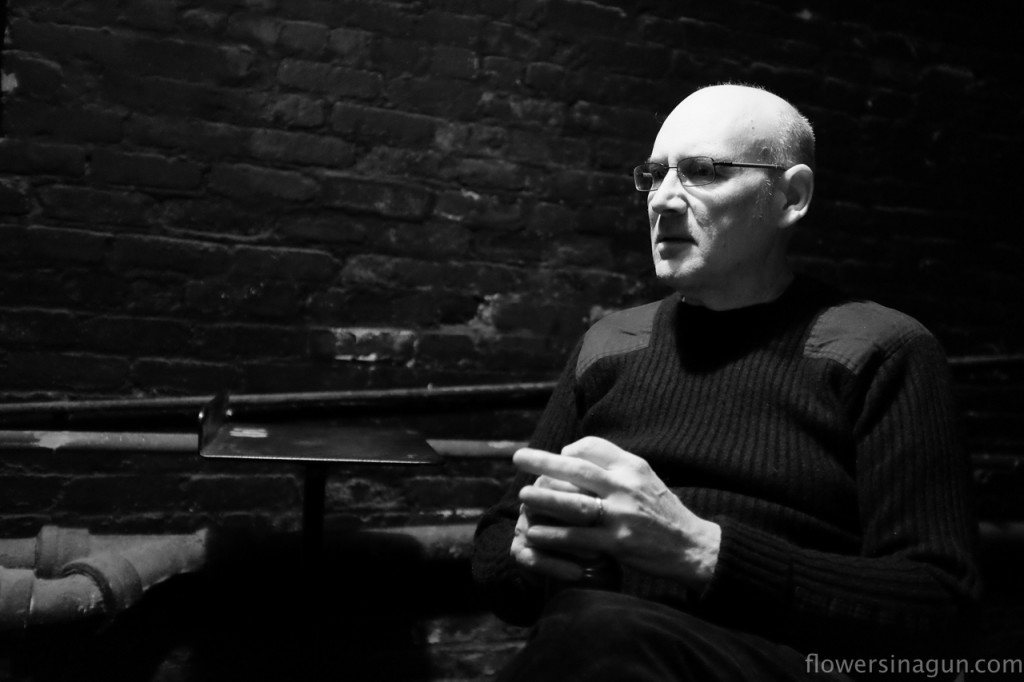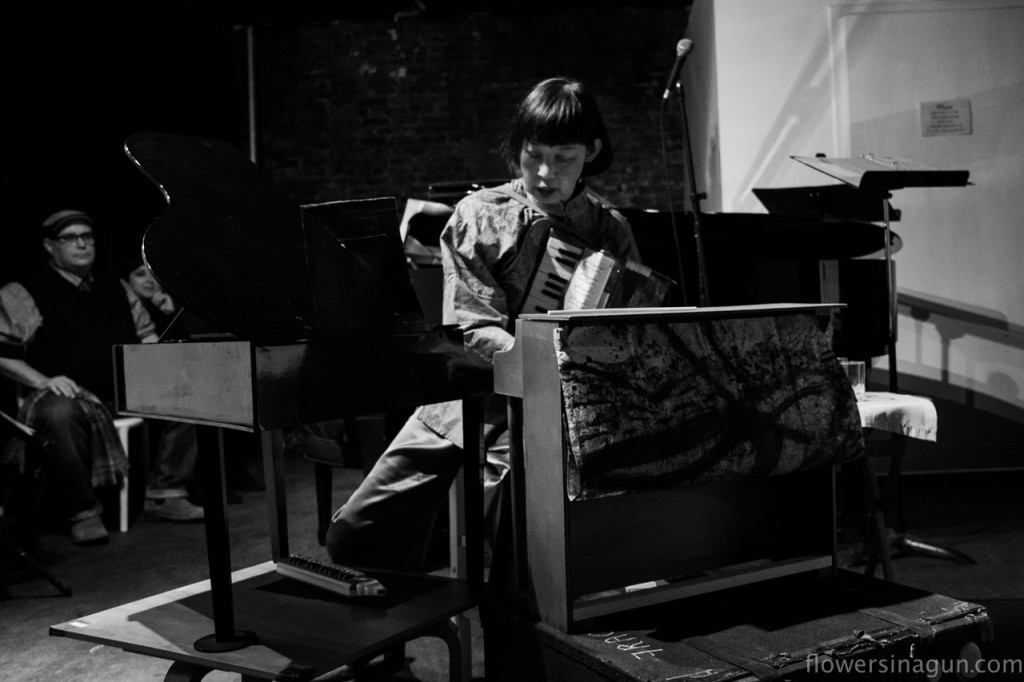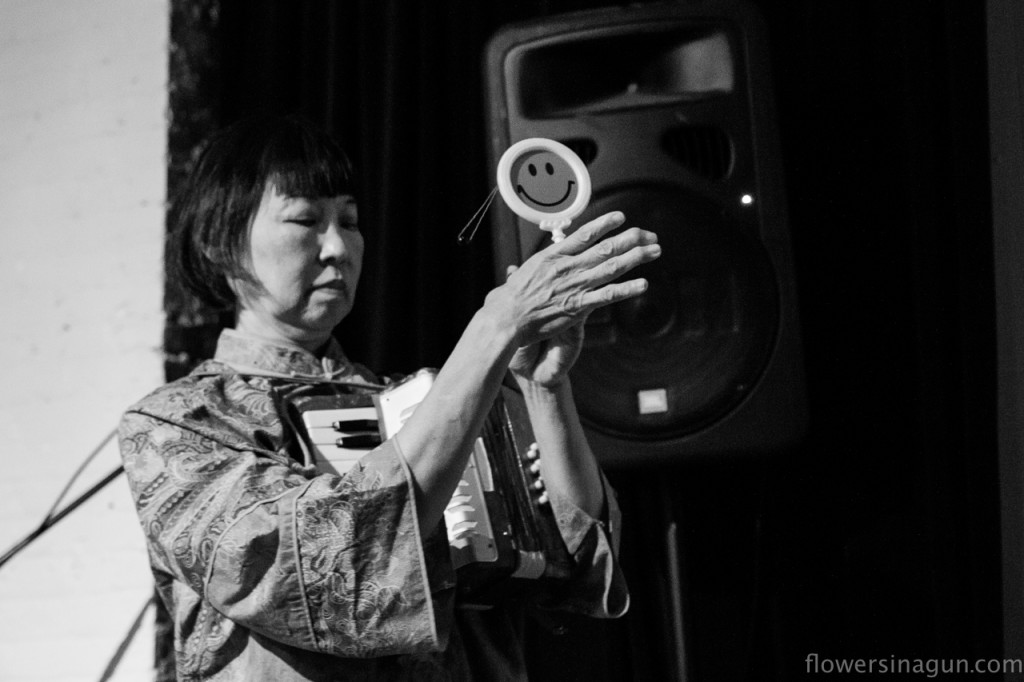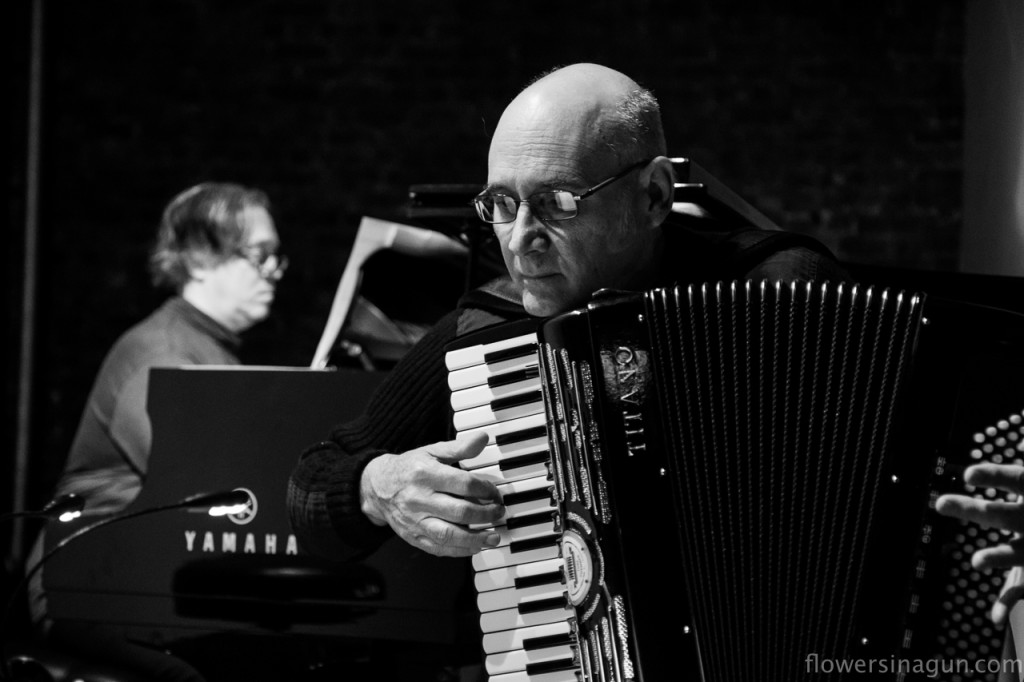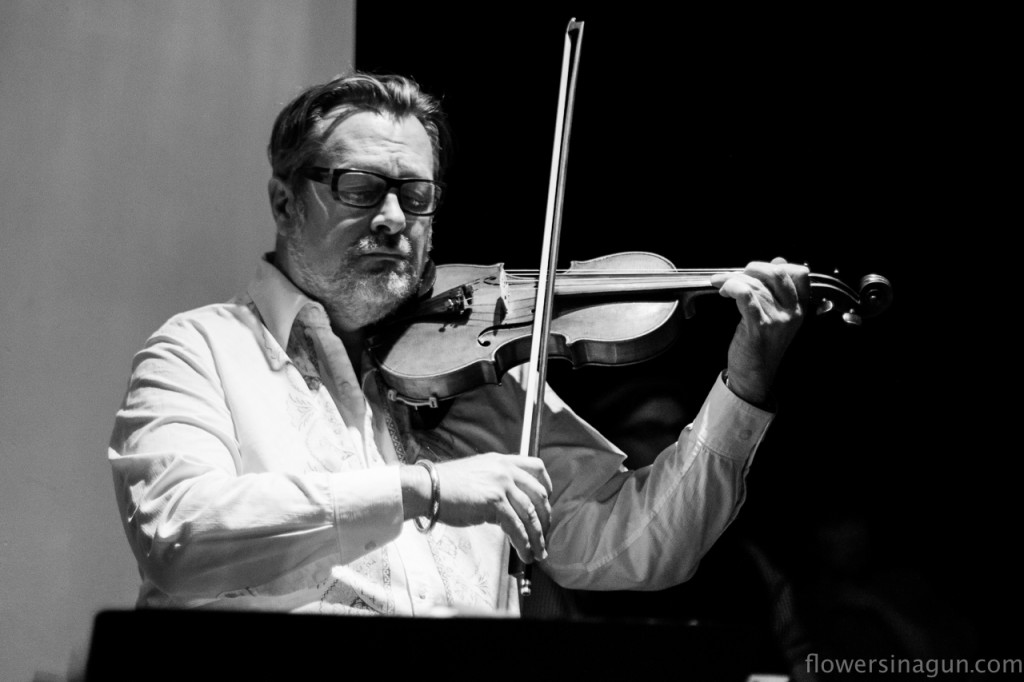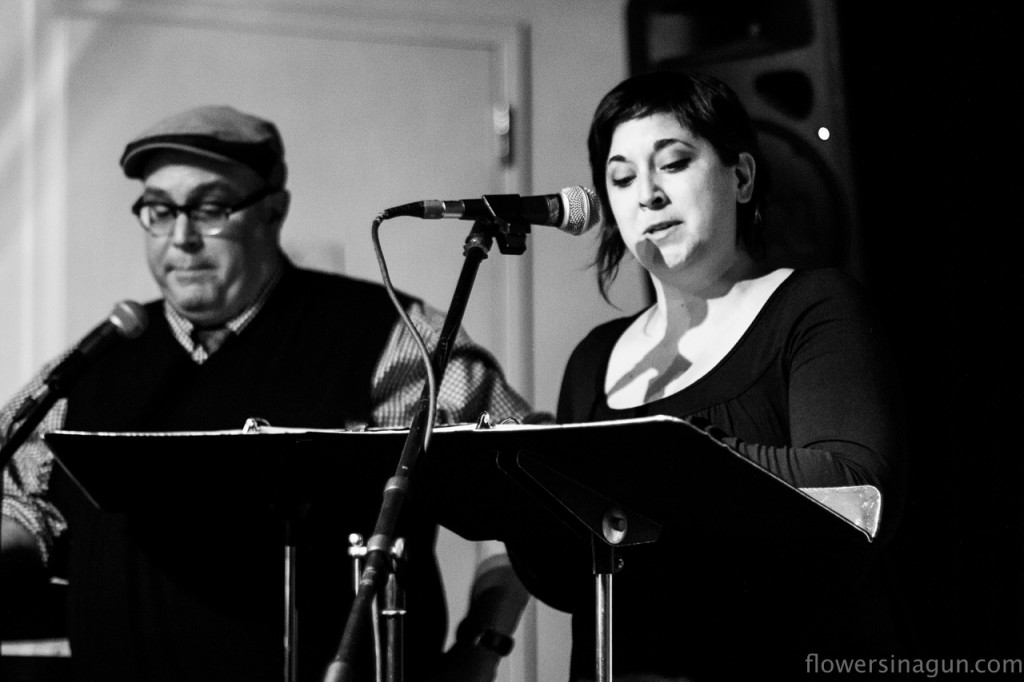The Stone is one of the few places left in New York City where you can hear avante-guard, experimental, improvisation based music. The Stone’s concert format, one week residency, gives musicians a space to collaborate, explore and create great atmosphere with less popular yet serious and unusual music.
Guy Klucevsek is one of the world’s most versatile and highly respected accordionist of our time. Hundreds of music pieces, collaborations and projects with world known composers and instrumentalists are followed by studio recordings and master classes all over Europe and North America. Guy Klucevsek gave a virtuoso performance at the Stone named “Teetering on the Verge of Normalcy”, featuring vocalists Peter Brown and Kamala Sankaram, Jed Distler on piano, Todd Reynolds on violin and Margaret Leng Tan. Tan’s experimental musical performance incorporated sounds from toy instruments – piano, mini drums, and vocal techniques you probably never heard before.
It’s like a mutual magic happening in the name of music. And even much more than that – talking about performers with tens of years of experience and lively excitement of still creating music not for the masses but for those who can go beyond the familiar sounds and explore that intimate art from different perspective.
It was amazing to interview Guy and you can find out more about his enjoyment of silence, why he wants young musicians to be careful with moving to New York City and what’s the room for improvement for after more than forty years on the world’s experimental music scene.
FIG: Seattle Weekly once stated that in order to hear your music in the right way we should forget everything we thought we knew about the accordion. What’s actually that thing we don’t know?
Guy Klucevsek: A lot of people don’t know that it could be a really diverse instrument. It could be more than a time counting instrument, not just folk music instrument that most people associate it with.
FIG: How did you choose it as your type of instrument? How is it related to your personality as an artist?
G.K.: Well, I was five years old when I chose it. I was just a kid who saw it on the television all the time, when I grew up in the 50’s accordion was the most popular instrument in America. So I would see it on television a couple of times a week. So I was attracted by it and I kept pestering my dad: “You gotta get me one, I want to play one of those, I have to play one…” He said he’s going to get me one but it’s really expensive so I had to wait one year. I started playing when I was five, five and a half… and played ever since, sixty years and so.
FIG: Were there moments when you gave up on playing?
G.K.: No, I think I could have given up certain parts of the repertoire. I grew up, in a Slovenian-American community in Pennsylvania, I was doing three things: I was playing Slovenian folklore music on the weekends, polkas and waltzes, then I was playing concert music when I was doing my studies with my teacher. And when I got to be around sixteen or eighteen, I was going to go music school and I was embarrassed by all these polkas and waltzes. I was trying to get it taken seriously. So, I really dropped that whole side of my personality for almost twenty years. And then I was in my forties probably when I met John Zorn. And he kind of uses any kind of music that you can imagine – from pop music, to rock and out jazz and out classical music but also some pop music, feel music, everything! So I started seeing that it is ok to go back and draw on the kind of music I played as a kid too and … I was already about forty when I think I started discovered my voice.
FIG: Is there something that you haven’t played yet?
G.K.: I’m always trying to figure out new ways to use the left hand – I have the right hand, the keyboard, pretty much covered. But the left hand is like a life-long mystery, especially cause I have other instrument – it’s called free bass which means it has all single tone, it’s not chords like folk instrument… and I didn’t start playing it till I was twenty. So as hard as I work on it, it’s still twenty years behind my right hand. It’s still bit of a mystery; I’ve only tapped twenty percent of what is possible to do with the left hand. I hope that I can find the other eighty percent.
FIG: You collaborate with many musicians – is it hard to stay in tone with all these different people and ways they play their music?
G.K.: It depends on who you’re playing with – when you’re working with John Zorn and Dave Douglas, they specifically write for the people they are working with. So they know where my strengths are, they know where my limitations are. I’m not really a jazz improviser, I’m not really a free improviser. I’m a classical musician who can improvise. So they don’t try to make me play chord changes, or something like that. They would like me to play solos, ivery complicated solos that will take advantage of my technique – challenge me technically, and rhythmically, things like that… And John Zorn likes very complicated written music cause he knows that I can deal with it. The same when he writes for Kronos Quartet, he writes very different than he’s working with the Masada Project; so he’s very smart about that. When you working with people and you know they’re good musicians, it’s a breeze, it’s no problem.
FIG: We would say that accordion is a cheery instrument, for playing happy music. What kind of music do you listen to when you’re sad or in a different and quieter kind of mood?
G.K.: I don’t really go to listen to pieces to fit my mood. Personally, if I have to be honest, I don’t listen to that much music because I spend all day writing music and practicing. And the last thing I want to do at night is to listen to four-five hours more music. First of all I have to give my ears a rest, it’s a muscle and like any other muscle and I’m using it all day long. So I’ll better go with reading a book, and silence, or cook. Silence is a beautiful thing. No radio, no podcast or something, just silence in the kitchen and the sound of water boiling. Cooking always picks up my spirits, I love to be in the kitchen. I’ve been married for forty five years and I’ve been the main cook for all that time – my wife works full time and I’m a freelancer.
FIG: She is a lucky woman.
G.K.: So am I. She has a job, so I’m very lucky. (laughing)
FIG: What else are you passionate about in your personal life?
G.K.: I love to go on long walks, hiking, walking with just no iPad, nothing in my ears – just listening to the sounds of nature. I live on Staten Island, we’re surrounded by water, a tender walk from my house – I can be right on the water that goes between Staten Island and New Jersey, and Staten Island and Statue of Liberty – and I can walk along the water there for like twenty-thirty minutes. And that’s a great passion. I just love reading, everything – from mysteries to philosophical criticism. Again, I think it’s the quiet and introversion… after the job I do – which is very extroverted, performing in public, I love those quiet moments too.
FIG: Your background is Slovenian. Having that in your geens – what’s the difference for you performing in front of European public and playing here, on American soil?
G.K.: It really depends on where you are in Europe. For instance, a lot of my music is influenced by folk music around the world and most cases – when I had my accordion tribe project with four Europeans and me, we played all over Europe, it was very successful. If you play in countries that were communist at one time, folk music was shoved down their throat, as nationalist music… So if you play music with folk roots, it brings bad memories for them. Lets say in Italy, for example, it was the only kind of music, folk music was the thing and it couldn’t be abstract. But for here, we don’t really have a folk music tradition, there isn’t one kind of American folk music – we have Appalachian music, we have Cajun music, Tex Mex, all it comes from somewhere else, so we don’t have our own folk music. For me, all those artists in Europe, most times they’re trying to get away from their roots and discover freer things. Here, a lot of us don’t have any roots, so we’re trying to discover them.
FIG.: How do you think music has changed in last twenty years, lets say?
G.K.: I don’t know so much in Europe. In America the predominance of the beat has been something that drives, even classical music… There is a lot of strong amplification, strong pulse, like a rock band. It’s now like a standard. It used to be that if you wanted to find classical musicians who could really play straight in tempo and who wanted to play with a lot of volume and wanted to be amplified was really unusual… Now everybody is used to playing with amplification, everybody has really good time. Before it was rare. Now even the kids, right out of the Julliard – they can play rock but they can also play like jazz time. So I think musicians that are coming from school now are much more versatile, they are not only virtuosos but their stylistic range is much greater than when I was a kid, when I was getting out of the collage.
FIG: What’s the next big project you’re planning on doing?
G.K.: I want to do another recording. It’s been four years since I’ve done a recording, so… probably it’s going to be Erik Friedlander on cello, some duals with Michael Lowenstern on clarinet, he’s one of my favorite musicians, Alan Burn that I played with last night here, we’re going to do some duos with piano. So, the recording is the best, I love the recording studio, working with engineers and recording as a media – It’s very exciting for me to be doing it again.
FIG: Do you agree that winter is more a productive season and better for inspiration, so you can do more creative things in term of art and particularly composing music? Or you’re waiting for summer, as we are. What are your plans for the high season?
G. K.: Actually, for the summer – I’m going to an artist colony to work on some music for a month. But I think you are right that the winter is more productive cause it’s more conducive to just nestling in and doing your work, and then cuddling with your spouse at night, just want to be indoors. But the summer … you want to be outdoors, and not going to work so much. So I think this is the time to get things done, yeah.
FIG: If you could give only one advice to young musicians that are just about to start performing, what would it be?
G.K.: The biggest piece of advice is that you don’t necessarily have to come to New York anymore. It’s a very expensive place to live, if you come here you gonna have five roommates and do a day job. When I came to New York, my rent was one hundred seventy-five dollars, we could afford it easily and we lived in Lower East Side. Now if you come to New York, you’ll probably live in Brooklyn, far reaches of Brooklyn, and even if you’re married couple, you would have to have room mates and both would have to have a day jobs… So, I would probably have to say, make a scene where you are. And if you outgrow your scene, then you move to the next nearest big city – Chicago, San Francisco, New Orleans, New York, Boston or wherever. But, you know, there are a lot of rock bands and jazz groups and they make scene where they are, or acting companies that they make scenes where they are. Don’t feel that it has to be New York. First of all, it’s hard to find any place to play in Manhattan any more, The Stone is one of the only venues left in New York to do alternative music. When I moved here in the 80’s there were twenty, thirty, forty, fifty places to play in Manhattan. Now the ones that are left are in Brooklyn and the Stone. People are asking me – where can I play in Manhattan, I say – The Stone. But now we have this format – one week per composer, so that doesn’t fit for people who are on tour and they want to do one night thing, so they have to find small club. So, stay where you are, form a scene, work really hard with other musicians in your small town, or city, and develop your own audience. If you can afford to make your own recordings in your garage or whatever, you’ll save money… and if your following gets big enough, take it out of town.
Author: Tsvete Tyuleva
Photo by Anna Yatskevich

